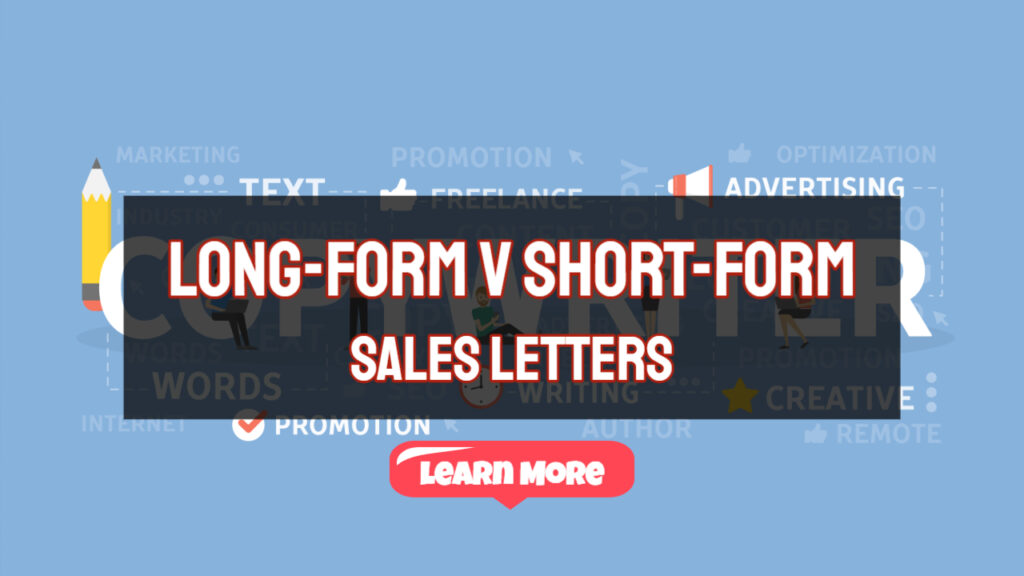Long-form vs Shortform Sales Letters
You send sales letters to prospects when you are proposing new items or services. They are a direct communication from you to them. Sales letters are written in the style of a salesperson, with the goal of persuading the reader to acquire something.
Sales letters can be classified primarily as either long-form or short-form, depending on their length. Long-form sales letters are often more elaborate, containing large blocks of text, whereas short-form sales letters are concise and direct in their communication with the customer.
Long-form versus short-form sales letters will be discussed in length in this article, as well as the distinctions between the two types of sales letters.
Long-form Sales Letters
Long-form sales letters are, as the name implies, lengthy versions of a sales letter. They are intended to provide the reader with information about the entire offer before making a purchase choice. Direct mail is a term used to describe a long-form sales letter that is sent to a specific address.
The length of a long-form sales letter is not specified, although it can be as lengthy as 10,000 words or even longer.
Long-form sales letters have shown to be very persuasive over time because they include in-depth information that is designed to help in decision-making and is therefore highly persuasive.
Most of the time, long-form sales letters persuade their readers by the accumulation of data that are provided in a logical order. One gets the idea that one is reading something serious while one is reading this.
Skimmers and customers who seek as much information as possible before making a buying choice are the primary reasons why long-form sales letters are effective.
When to Use Long-form sales letters
Long-form sales letters work well [1] while advertising your products or services to those who have never heard of you before. These are first-time visitors to your website who have never heard from you before.
A long-form sales page will assist you in gaining their confidence since you will explain to them the specific reasons why they should purchase your goods or service on it.
Another situation in which long-form sales letters are appropriate is when your product comes with additional offers.
This is particularly common when you are launching a large campaign and have packaged your products/services with additional goodies to make the transaction appear more appealing.
Finally, when your product or service has a high price tag, long-form sales letters are employed to convey this information. It might be anything from a $500 down payment to tens of thousands of dollars offer. Your target audience will consider this to be a significant financial commitment, making it vital to write a lengthy sales letter that covers all of their issues in detail.
Short Form Sales Letters
In sales, a short-form sales letter is most often used when you want to convince a reader to learn more about a product or service, or when you want to pitch an offer that the reader is already aware of.
Short-form sales letters have the benefit of appealing to people's natural desire to know more about what they are selling. Aside from that, they give basic information that a reader could want while making a purchase.
When To Use Short-form sales letters
Sales pages that are short in length are also employed when the product you are promoting is straightforward and doesn't require a lot of information to sell. In this situation, the reader is only given the opportunity to engage with information that defines whether or not the product meets their requirements.
A short-form sales letter may also be used to market low-cost offerings that do not necessitate making significant financial commitments on your part. A long-form sales letter is not required for such offers because there are few objections that need to be addressed in the first place.
Differences between Long-form and Short-form Sales Letters
Need-based and value-based proposition
When you write a long-form letter, you are more likely to include need-based proposals that will persuade your prospects that they require what you are providing them.
Necessity-based propositions provide answers to issues such as “why should I buy your product?” and “what problem does your product solve.”
In contrast to long Form letters, shorter ones are more likely to contain value-based propositions that will persuade prospects that they would profit from doing business with you.
Answering queries such as “what can I gain from purchasing your products or services?” are examples of value-based propositions. In other words, it explains what consumers stand to gain if they choose to pay you for your items.
Also keep in mind that long-form sales letters are more likely to include lessons or teaching points regarding the product or service you are giving than short-form sales letters.
Short-form sales letters, on the other hand, would be more clear and straight-to-the-point in terms of what readers may anticipate from your product or service and what they would receive as a result.
Details and urgency
In contrast to short-form sales letters, long-form sales letters have a better chance of delivering enough information on the product or service you are selling so that potential customers know exactly what to anticipate from your product or service before making a purchase.
Short-form sales letters are focused on presenting only the information that a reader requires in order to make a decision about your product or service. Short Form sales letters are more straightforward and to-the-point than long Form sales letters, making them more appealing to those who need to make quick judgments.
Conclusion
To summarize, long-form sales letters are employed when you have more material that can assist your prospects in getting a better understanding of your product or service. Long-form sales letters are the ideal choice when it comes to selling items or services that need significant time or financial commitments on your part.
Customers who are looking for a quick and easy approach to determine whether a product or service will meet their needs may find short-form sales letters to be more tempting. As a result, they have a higher likelihood of being shared because readers are required to invest less time and effort in learning about the product or service being offered.
References
[1] https://vwo.com/blog/long-form-sales-letters/
The post Long-form vs Short-form Sales Letters – The Differences appeared first on https://gqcentral.co.uk




